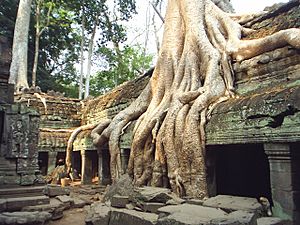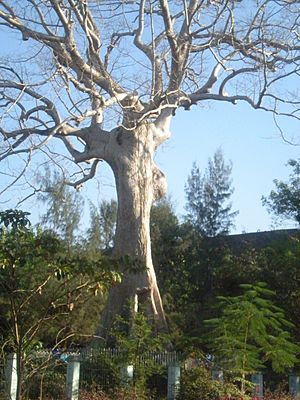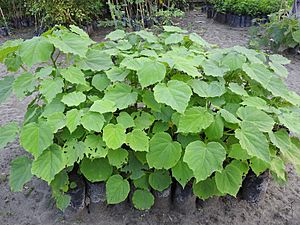Tetrameles facts for kids
Quick facts for kids Tetrameles |
|
|---|---|
 |
|
| The famous spung tree growing in the Ta Prohm temple ruins in Cambodia is Tetrameles nudiflora | |
| Conservation status | |
| Scientific classification | |
| Genus: |
Tetrameles
|
| Species: |
nudiflora
|
Tetrameles nudiflora is a very large tree that loses its leaves every year. It is the only type of tree in its group, called a genus, which is named Tetrameles. This amazing tree grows in many parts of Asia, from India to Australia. It is known for its huge size and strong roots.
Contents
What is Tetrameles nudiflora?
Tetrameles nudiflora is a special kind of flowering plant. It belongs to a small plant family called Tetramelaceae. There are only two types of trees in this family, and Tetrameles nudiflora is one of them. Scientists used to group it with other plants, but they found that it was unique.
How to Spot a Tetrameles nudiflora Tree
Tetrameles nudiflora is a giant tree. It can grow taller than 45 meters (about 150 feet). That's like a 15-story building! Its branches can spread out over 10 meters wide. The trunk of the tree is very wide at the bottom, like a strong base. This helps the tree stand tall.
The bark of the tree is grey and often looks shiny. You might also notice big hollow spaces in its trunk or branches. This tree loses all its leaves once a year. In Australia, this happens between October and December. In Vietnam, it's usually from January to April.
The name Tetrameles comes from ancient Greek words meaning "four parts." This is because its flowers have four sepals, which are like small leaves that protect the flower bud. The second part of its name, nudiflora, means "bare flowers" in Latin. This refers to the flowers appearing when the tree has no leaves.
Where Tetrameles nudiflora Grows
This tree loves warm, wet places. It grows in subtropical and tropical forests. You can find Tetrameles nudiflora in many countries. These include India, Sri Lanka, Bangladesh, Bhutan, Burma, China, Laos, Cambodia, Thailand, and Vietnam. It also grows in Malaysia, Indonesia, and even in northern Queensland, Australia.
In India, many of these trees grow in the Thattekad Bird Sanctuary in Kerala. In Myanmar, there is a very old and tall tree, about 60 meters (200 feet) high, at the University of Yangon. In Vietnam, these trees are called tung or thung. You can see some beautiful ones in Cat Tien National Park.
How People Use Tetrameles nudiflora
Because Tetrameles nudiflora trees grow so big, they are best suited for large areas. You often see them in nature reserves, big parks, or other open spaces. They are usually too big for private gardens.
Even though its wood is soft, people in New Guinea use it to make canoes. This tree is also helpful for growing new forests. It doesn't need very deep soil to grow. This makes it a good "colonizer" species, meaning it can be one of the first trees to grow in an area and help other plants follow.
See also
 In Spanish: Tetrameles para niños
In Spanish: Tetrameles para niños








